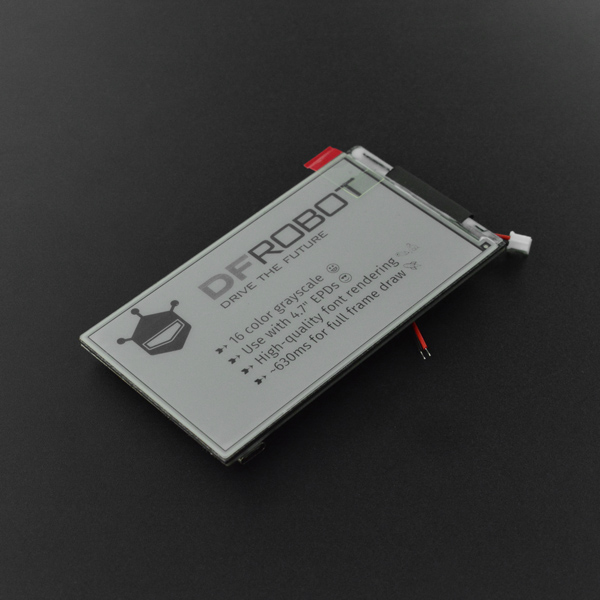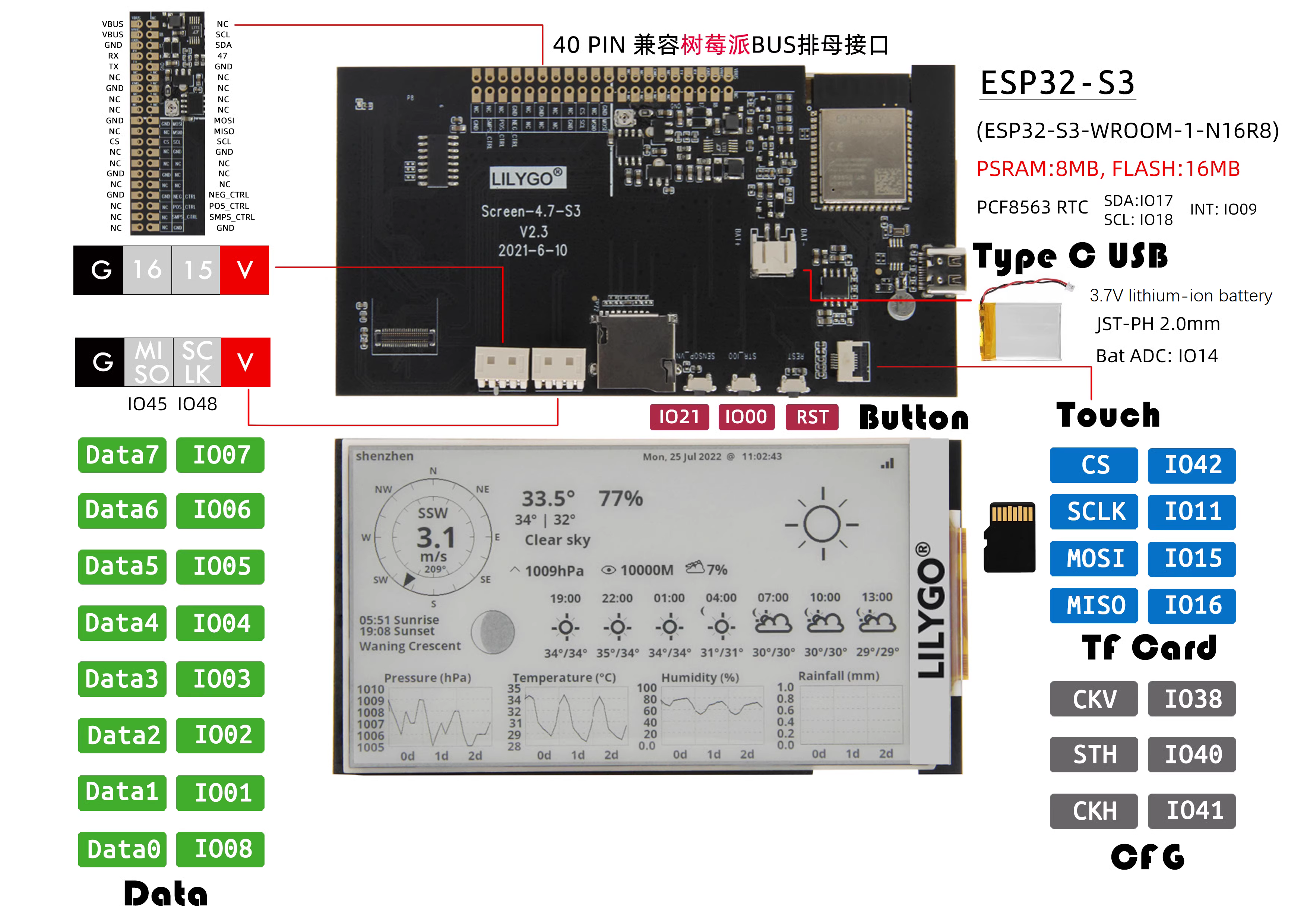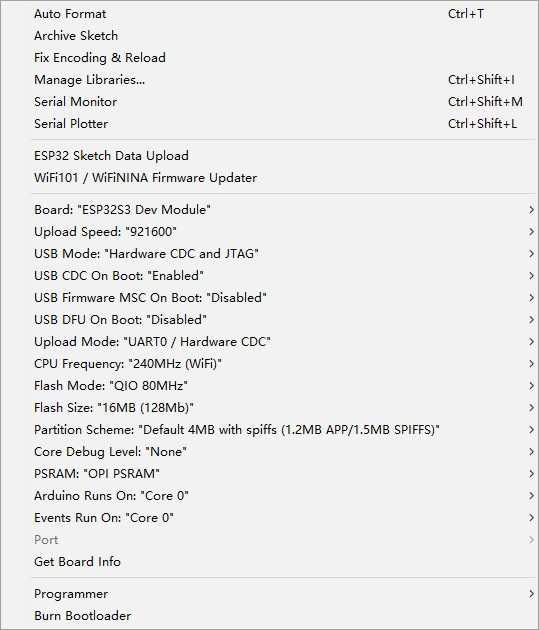
Introduction
This is an E Ink display controller device designed to be used with a touchscreen. It features the ESP32-S3-WROOM-1-N16R18 controller with 16MB Flash and 8MB PSRAM built-in. The front side includes a 4.7-inch E Ink display with a resolution of 540x960, supporting 16-level grayscale and partial refresh.
In comparison to a regular LCD screen, an E Ink display provides users with a better text reading experience, along with low power consumption and image retention when powered off. It also includes a 6-pin touchscreen interface for optional accessories, catering to your specific application needs. On the side, there are 3 reserved buttons, with 2 customizable buttons for flexible functionality and one reset button. Additionally, it features a 40-pin header compatible with Raspberry Pi's BUS interface. On the back, there is a PH 2.0 spaced 3.7V battery socket.
Specification(4.7-inch E Ink display for ESP32)
- Controller: ESP32-WROVER-E (ESP32-D0WDQ6 V3)
- Flash: 16MB
- PSRAM: 8MB
- Resolution: 540(H)×960(V)
- Display Grayscale Level: 16 levels
- Custom Buttons: 3
- IO Port: 7
- Battery Interface: PH 2.0 interface
- Battery Charge and Discharge Protection Chip: HX6610S
- Display Size: 4.7 inches
- Partial Refresh: support
- Touch Screen Interface: 6pin touch screen interface
Specification(4.7-inch E Ink display for ESP32-S3)
- Controller: ESP32-S3-WROOM-1-N16R18
- Flash: 16MB
- PSRAM: 8MB
- Resolution: 540(H)×960(V)
- Display Grayscale Level: 16 levels
- Custom Buttons: 2
- Battery Connector: PH 2.0 interface
- Battery Charge and Discharge Protection Chip: HX6610S
- Display Size: 4.7 inches
- Partial Refresh: support
- Touch Screen Interface: 6pin touch screen interface
Applications
- Desktop weather station
- STEM education
- IOT equipment
- Shelf label
- Message board
Board Overview
4.7-inch E Ink display for ESP32

4.7-inch E Ink display for ESP32-S3

Tutorial
Requirements
-
Hardware
- ESP32 Ink Screen 4.7" ×1
-
Software
- Arduino IDE
- Download and install the EPD47 Library. (About how to install the library?)
Install the development environment
- Configure URL to the Arduino IDE
- Open Arduino IDE and click File->Preferences, as shown below.

- In the newly opened interface, click the button in the red circle as shown below

- Copy the following link into the new pop-up dialog box: https://raw.githubusercontent.com/espressif/arduino-esp32/gh-pages/package_esp32_index.json
Note: If you have installed another environment before, you can press Enter key at the beginning or end of the previous link and paste the link at a new line.

- Click OK. Update the board. Open Tools->Board:->Boards Manager... as shown below:

- Boards Manager will automatically update the boards as shown below:

- After completing the update, you can enter esp32 at the top, select esp32 and click install when the following occurs (It's recommended to install the latest version):

- Wait for the end of the following progress bar:

- After completing the installation, the list will show that the esp32 has been installed, as shown below:

- Select the development board and set the development board parameters as shown in the picture below, select the correct port.
4.7-inch E Ink display for ESP32

4.7-inch E Ink display for ESP32-S3

Display text and picture example
- Open the example in File>Examples>EPD47>demo of Arduino IDE

- Upload the program to the E-ink screen, the E-ink screen will display as shown in the following picture.

Please use the scripts in the "EPD47\scripts" directory to generate pictures and texts. Please refer to the script instructions for specific usage. (The script must be used in the Linux environment)
Refresh picture example
- Open the example in File>Examples>EPD47>drawImages of Arduino IDE

Grayscale test example
- Open the example in File>Examples>EPD47>grayscale_test of Arduino IDE

- Upload the program to the E-ink screen, the E-ink screen will display as the following picture.

Touch screen example
- Correctly connect the 4.7" capacitive touch screen with the ESP32 E-ink screen 4.7". There is 3M tape on the back of the touch screen, which allows you to directly stick the touch screen on the E-ink display.

- Open the example in File>Examples>EPD47>touchtest of Arduino IDE

- Result

Font/picture conversion script
- Please use the scripts in the "EPD47\scripts" directory to generate pictures and texts. Please refer to the script instructions for specific usage.
(The script must be used in the Linux environment)
FAQ
For any questions, advice or cool ideas to share, please visit the DFRobot Forum.